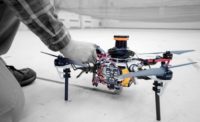A military software developer is preparing to release an enterprise-level drone hardware and software operating package called DroneOS that runs avionics and a ground-control system mounted right on the aircraft. DroneOS is now in beta testing and publicly available next year.
“We're very cognizant of the fact that without platforms out there there's nothing to build on,” says Nelson Paez, CEO DreamHammer, San Diego. He says DroneOS is that platform. “It’s built for aerospace requirements to power industrial-grade birds,” he says.
DroneOS is a drone-mounted brain that weighs as much as an iPhone 5 and has the processing muscle of a powerful server, says Paez. It has an Ethernet port and can communicate via cell signal, Bluetooth and WiFi. The OS comes with self-monitoring capabilities and can report its location and track flights. It has autopilot and an avionics system to manage the UAV while it flies. The OS is an open-source product for which third party developers can build custom applications.
Lloyd Garden, owner and operator of Drone Promotions, Truckee, Calif., says the fact that DroneOS is open-source is significant and sets it apart from other drone-control software in the market, such as that used proprietarily by drone maker DJI. “It’s pretty much exactly like DJI—they have an app called DJI Go that works with all their drones, [but] it’s just not open source, and other developers can’t develop on it, like they can for DroneOS.”
If users aren’t flying DJI—the most popular consumer-level drone manufacturer—and are instead using MOVI or 3D Robotics drones or building their own UAV’s, that’s where DroneOS comes in, says Garden. “It’s for construction and mapping,” he says, because those industries need enterprise-level birds. Paez adds that the platform will open up new doors for construction.
"We built it in a way that allows for edge computing so the drones themselves are smarter," says Paez. The construction industry really wants 3D models from the air to help detect potential issues on site, and the only way that they can get that is with computer vision and algorithms, says Paez. A program could find, for example different components that aren't up to code and tell the operator while he concentrates on flying.
“No one is doing it yet,” says Paez. “But you can't do it without the platform.” Paez won’t name a price for DroneOS because he says it is not finalized. He adds, though, that, "It's going to be priced in such a way that it's easily mass adoptable. It won't be consumer pricing but not far from it."
He says the release is aligned with the Federal Aviation Administration’s timetable on releasing rules for commercial drones.




